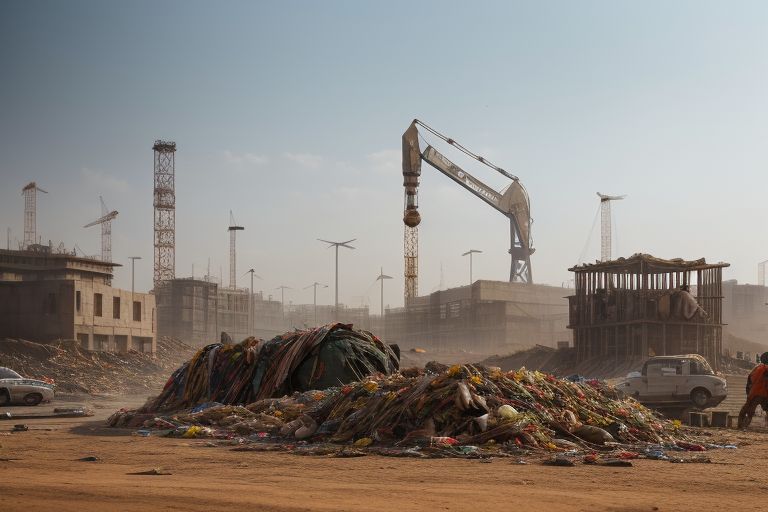- [email protected]
- +254 723 065019
- Mon - Sat 9:00 AM - 5:00 PM
- Login or Register
- Favorites
5.1 Understanding Construction Waste
Lesson 5.1: Understanding Construction Waste
Welcome to Lesson 5.1, where we dive into the critical topic of construction waste. In this lesson, we’ll explore the nature and scope of waste generated during construction projects, including its various forms and impacts. Understanding construction waste is the first step in developing effective strategies to manage, reduce, and recycle it, contributing to a more sustainable building industry.
We’ll cover key aspects such as:
- The types and sources of construction waste
- The environmental and economic impacts of waste
- Best practices for waste management on construction sites
Learners will gain a comprehensive understanding of construction waste, including its types, sources, and impact. They will learn how to identify, categorize, and assess construction waste to improve waste management practices.
Objective:
By the end of this lesson, learners will:
- Understand Construction Waste: Gain a thorough understanding of what constitutes construction waste, including its various types and sources.
- Identify and Categorize Waste: Learn how to identify and categorize different types of construction waste, such as concrete, wood, metal, and hazardous materials.
- Assess Waste Impact: Explore the environmental and economic impacts of construction waste, including how it affects landfills, natural resources, and project costs.
- Improve Waste Management Practices: Develop strategies to assess and manage construction waste more effectively, leading to better waste reduction, recycling, and disposal practices.
Through these objectives, learners will be equipped with the knowledge and tools needed to enhance waste management on construction sites and contribute to a more sustainable construction industry.
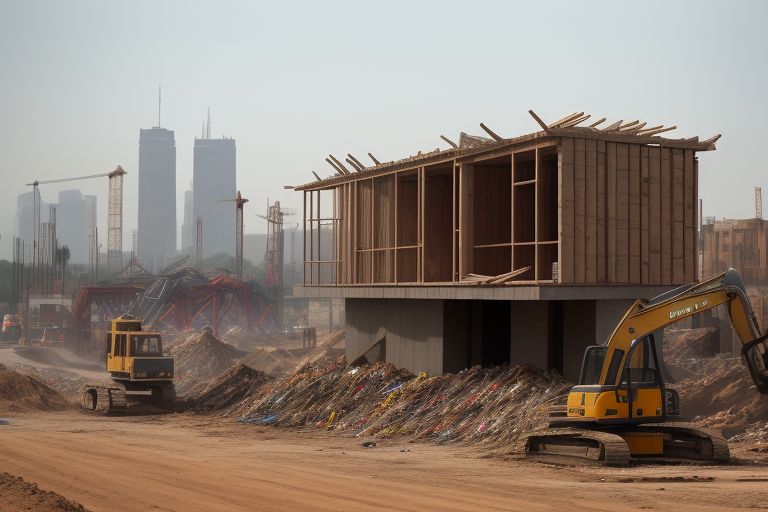
1. Introduction to Construction Waste
In the construction industry, managing waste effectively is crucial for both environmental sustainability and economic efficiency. Construction waste refers to the materials and by-products generated during the construction, renovation, and demolition of buildings and infrastructure. This waste can come from a variety of sources and includes a range of materials, from concrete and wood to metals and hazardous substances.
Understanding construction waste involves recognizing the different types of waste produced, identifying their sources, and evaluating their impact on the environment and project costs. Proper management of construction waste not only reduces the strain on landfills but also promotes resource efficiency and supports sustainability goals.
In this section, we will explore:
- Definition and Types of Construction Waste: What constitutes construction waste and the various categories it encompasses.
- Sources of Construction Waste: How and where waste is generated throughout the construction process.
- Impact of Construction Waste: The environmental and economic consequences of improper waste management.
By grasping these fundamental concepts, you’ll be better prepared to implement effective waste management strategies and contribute to more sustainable construction practices.
Key Points:
a. Definition of Construction Waste>
Construction waste encompasses the materials and by-products produced during the processes of construction, renovation, or demolition of buildings and infrastructure. This type of waste can vary widely, including:
- Demolition Debris: This includes materials such as concrete, bricks, wood, and metal that are generated when existing structures are dismantled or demolished. These materials often need to be sorted for recycling or disposal.
- Construction By-Products: During the building phase, excess materials are frequently produced. These include items like insulation, drywall, and flooring that may be left over or discarded. Proper management of these by-products is crucial to minimize waste.
- Renovation Waste: When remodeling or upgrading buildings, materials such as cabinetry, fixtures, and old roofing are removed or replaced. This type of waste requires careful handling to either repurpose or dispose of the materials responsibly.
Understanding these categories helps in effectively managing and mitigating the impact of construction waste, promoting recycling, and reducing the overall environmental footprint of construction activities.
b. Importance:
Understanding construction waste is essential for several reasons:
- Developing Effective Waste Management Strategies: Knowledge of the different types of construction waste allows for the creation of targeted strategies to minimize waste generation. By identifying and categorizing waste materials, effective plans can be implemented to reduce the volume of waste produced and enhance recycling and reuse practices.
- Reducing Environmental Impact: Proper management of construction waste is crucial for mitigating environmental harm. Effective waste management reduces the amount of waste sent to landfills, decreases pollution, and conserves natural resources. Recycling and reusing materials help lower the ecological footprint of construction activities, supporting more sustainable practices.
- Complying with Regulations: Many regions have specific regulations and standards governing the management of construction waste. Understanding the types and implications of waste ensures compliance with these legal requirements, helping to avoid fines, penalties, and potential legal issues. Adhering to these regulations also promotes responsible industry practices.
Recognizing and addressing the types and significance of construction waste is a fundamental step towards improving waste management practices. It contributes to a more sustainable construction industry and supports environmental conservation efforts.
Reflection Element:
Reflect on the potential environmental and economic impacts of construction waste if not managed properly.
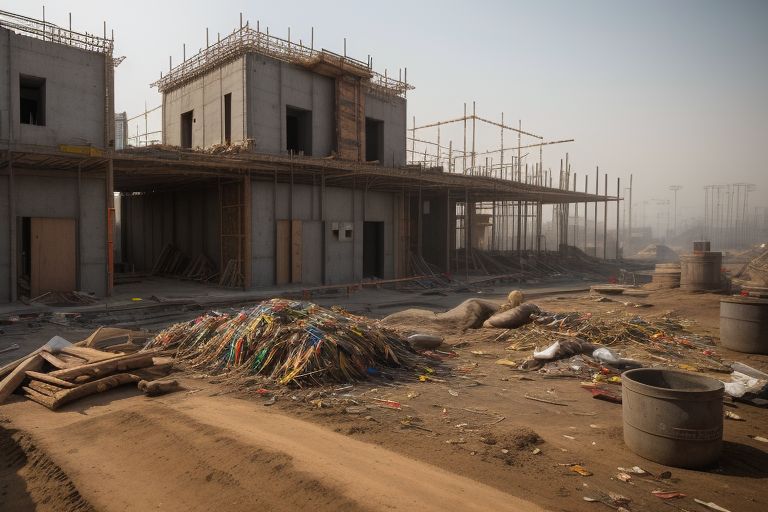
2. Types of Construction Waste
Understanding the various types of construction waste is crucial for effective waste management and sustainable practices. Construction projects generate a diverse range of waste materials, each with its own characteristics and management needs. By categorizing these materials, we can better implement strategies for reduction, recycling, and proper disposal.
In this section, we will explore the different types of construction waste, including demolition debris, construction by-products, and renovation waste. Recognizing the specific types of waste produced during construction, renovation, and demolition activities helps in developing targeted approaches to manage and minimize waste effectively. This knowledge is essential for improving overall sustainability in construction practices and ensuring efficient use of resources.
Key Points:
a. Municipal Solid Waste (MSW)
Municipal Solid Waste (MSW) encompasses general waste produced during construction activities that resembles typical household waste. This category includes items that are generally not suitable for recycling or reuse and are often discarded as regular trash. MSW from construction sites can contribute to the overall volume of waste needing disposal, affecting landfill capacity and waste management systems.
Examples:
-
- Packaging Materials: Cardboard boxes, plastic wraps, and other packaging used for transporting construction materials.
- Food Wrappers: Disposable wrappers or containers from meals consumed on-site.
- Plastic Bags: Single-use plastic bags used for various purposes on the construction site.
- Other Non-Recyclable Items: Items such as broken tools, contaminated materials, or any other waste that cannot be easily sorted or recycled.
Understanding and managing MSW is crucial for reducing the impact of construction activities on landfills and improving overall waste management practices.
b. Construction and Demolition Debris
Construction and demolition debris refers to materials specifically generated from construction, renovation, and demolition activities. This category includes bulky and heavy materials that, due to their volume and weight, often require specialized handling. Many of these materials can be repurposed or recycled, which helps to reduce the environmental impact of construction activities and supports sustainable waste management practices.
Examples:
-
- Concrete: Leftover concrete from pours, demolished concrete structures, or broken concrete slabs.
- Bricks: Salvaged bricks from dismantled walls or structures, which can often be cleaned and reused.
- Wood: Scraps, off-cuts, or old wood from demolished structures or construction processes.
- Metal: Metal debris such as steel beams, rebar, and aluminum siding that can be recycled or repurposed.
- Drywall: Sheets of drywall from interior construction or renovation projects.
- Insulation: Used or excess insulation materials that were removed or replaced during construction or demolition.
- Roofing Materials: Old roofing tiles, shingles, or metal roofing that are replaced during renovation or demolition activities.
Proper management of construction and demolition debris is essential for minimizing landfill use, promoting recycling, and reducing the overall environmental footprint of construction projects.
c. Hazardous Waste
Hazardous waste includes materials that pose a significant risk to human health or the environment due to their chemical properties. These materials are dangerous and can cause severe health problems or environmental damage if not handled and disposed of correctly. Special procedures and regulations govern the management of hazardous waste to ensure safety and compliance.
Examples:
-
- Asbestos: A fibrous mineral used in construction materials for its fire-resistant properties. When disturbed, asbestos fibers can become airborne and pose serious health risks, including lung disease and cancer.
- Lead-Based Paint: Paint that contains lead, which was commonly used in older buildings. Lead exposure can cause health issues, particularly in children, including developmental delays and neurological damage.
- Solvents: Chemicals used for cleaning or as part of construction processes, such as paint thinners, degreasers, and varnishes. These substances can be toxic and may pose risks to respiratory health and the environment.
- Certain Chemical Cleaners: Cleaning agents that contain hazardous chemicals, which can be harmful if ingested, inhaled, or if they come into contact with skin.
- Treated Wood: Wood that has been chemically treated to resist decay or pests. The chemicals used in treatment can leach into the soil or groundwater and pose environmental risks.
Effective management of hazardous waste is critical for protecting both public health and the environment. This involves adhering to specific regulations, utilizing proper containment and disposal methods, and ensuring that workers are trained in handling these materials safely.
d. Green Waste
Green waste refers to organic materials produced from landscaping activities and the removal of vegetation. Unlike other types of construction waste, green waste is biodegradable and can be effectively processed into compost or other useful products. Proper management of green waste contributes to sustainability by reducing landfill use and supporting soil health.
Examples:
-
- Tree Branches: Limbs and branches removed during tree pruning or clearing. These can be chipped into mulch or composted.
- Leaves: Fallen leaves collected from yards and gardens. Leaves can be composted or used as mulch to improve soil health.
- Grass Clippings: Trimmings from mowing lawns. Grass clippings can be left on the lawn as natural fertilizer or collected for composting.
- Other Plant-Based Materials: Includes cuttings from shrubs, flowers, and other plants. These materials are ideal for composting or turning into mulch.
Benefits of Managing Green Waste:
-
- Reduces Landfill Use: By composting or repurposing green waste, less material ends up in landfills.
- Enhances Soil Health: Compost from green waste adds valuable nutrients to the soil, improving its structure and fertility.
- Supports Sustainable Practices: Using green waste effectively helps create a closed-loop system that benefits the environment and reduces waste.
e. Recyclable Materials
Recyclable materials are waste products that can be processed and repurposed into new construction materials. By sorting and recycling these materials properly, construction projects can significantly reduce the volume of waste sent to landfills and conserve valuable natural resources. Effective recycling practices contribute to sustainability and can lower overall project costs.
Examples:
-
- Reclaimed Wood: Wood salvaged from old buildings or demolition sites. It can be reused in new construction projects or repurposed for furniture and decorative elements.
- Metal Scraps: Metals such as steel, aluminum, and copper recovered from construction sites. These materials can be melted down and reformed into new metal products.
- Cardboard: Packaging material that can be recycled into new paper products. Proper disposal and sorting of cardboard prevent it from ending up in landfills.
- Certain Plastics: Plastics like polyethylene and polypropylene that can be processed and used in new construction materials or other applications.
- Recyclable Packaging Materials: Items like glass, plastic containers, and metal cans used in packaging. These materials can be sorted and recycled to reduce waste and support resource recovery.
Benefits of Managing Recyclable Materials:
-
- Reduces Landfill Waste: Recycling keeps materials out of landfills, conserving space and reducing environmental impact.
- Conserves Natural Resources: Reusing materials reduces the need for virgin resources, lowering the environmental footprint of new construction.
- Lowers Project Costs: Recycling materials can decrease waste disposal costs and sometimes reduce the cost of purchasing new materials.
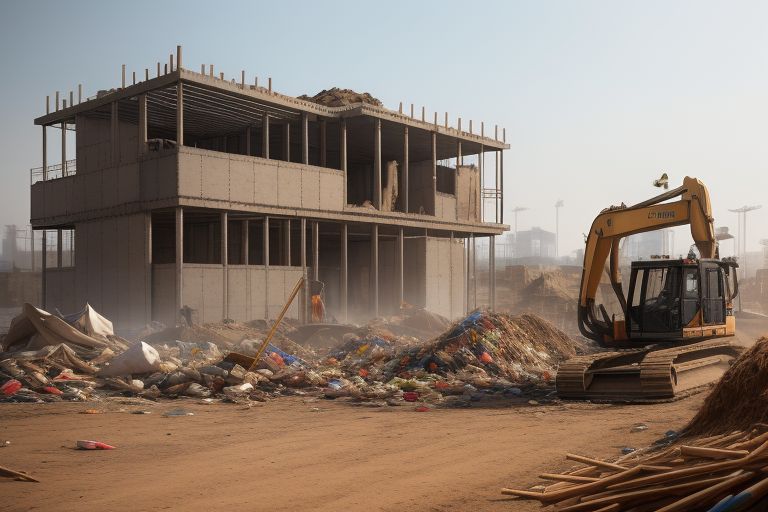
3. Sources of Construction Waste
Understanding the sources of construction waste is crucial for developing effective waste management strategies. Construction waste originates from various stages of a project, from initial planning to final cleanup. By identifying these sources, stakeholders can implement targeted measures to minimize waste, improve recycling efforts, and enhance overall sustainability.
This section will explore the key sources of construction waste, including materials and activities that contribute to waste generation. By examining these sources, we can better understand where waste is produced and how to address it, ultimately leading to more efficient and environmentally-friendly construction practices.
Key Points:
a. Over-ordering of Materials
Over-ordering of materials occurs when more resources are purchased for a project than are actually needed. This excess typically arises from inaccurate initial estimates, miscalculations, or a lack of effective communication between suppliers and project managers. Factors such as overly cautious ordering practices or a misunderstanding of project requirements can also contribute to this issue.
The primary consequence of over-ordering is the creation of surplus materials that often end up as waste. Unused materials may be discarded, left to deteriorate, or become obsolete if they cannot be used in future projects. This not only results in wasted resources but also incurs additional costs for disposal. Furthermore, the environmental impact of disposing of excess materials contributes to larger landfill volumes and increased pollution. Effective inventory management and precise estimation can help mitigate these problems, leading to more sustainable practices and cost savings.
b. Inefficient Design and Planning
Inefficient design and planning refer to scenarios where project designs are flawed or inadequately prepared, leading to the use of more materials than necessary. This inefficiency can manifest through errors in sizing, cutting, or fitting, where materials are not used optimally. For example, poorly thought-out plans may result in excess off-cuts, excessive scraps, or mismatched components, all of which contribute to unnecessary waste.
The consequences of inefficient design and planning are multifaceted. Increased material waste results from errors in measurement and cutting, leading to higher costs and a greater environmental footprint. Excess material discarded as scrap not only represents a financial loss but also adds to the volume of waste requiring disposal. To mitigate these issues, it is crucial to invest in thorough design processes, detailed planning, and precision in execution. Enhanced planning and design can reduce material waste, lower costs, and contribute to a more sustainable construction process.
c. On-site Handling and Storage Issues
On-site handling and storage issues arise when construction materials are not managed properly during their time on the construction site. Improper handling can include exposure to adverse weather conditions, accidental damage during movement, or vandalism. Additionally, inadequate storage practices, such as leaving materials exposed or improperly stacked, can further exacerbate the problem. These factors often lead to the deterioration or damage of materials, which results in their disposal and contributes to overall waste.
The impact of on-site handling and storage issues is significant. Damaged materials not only lead to increased project costs due to the need for replacements but also contribute to environmental waste. Materials that are exposed to the elements or mishandled are often discarded, adding to the volume of waste that must be managed and disposed of. Effective handling and storage practices are crucial in minimizing material loss, reducing unnecessary expenditures, and supporting sustainable construction practices. Implementing proper storage solutions, training personnel, and securing materials against potential damage can significantly reduce waste and enhance overall project efficiency.
d. Demolition Activities
During demolition activities, substantial amounts of debris are generated as existing structures are dismantled. This debris can include a variety of materials such as concrete, bricks, wood, metals, and sometimes hazardous substances like asbestos or lead-based paint. Demolition waste also often contains valuable recyclable materials that can be reclaimed and repurposed. Effective management of this waste involves sorting materials for recycling and ensuring hazardous substances are handled and disposed of according to regulatory guidelines.
The impact of demolition waste is significant both environmentally and financially. If not managed properly, demolition debris can contribute to large volumes of landfill waste, exacerbating environmental issues and increasing disposal costs. Properly sorting and recycling materials can reduce the amount of waste sent to landfills and conserve natural resources. Additionally, managing hazardous materials with care helps to mitigate health risks and environmental contamination. By adopting best practices in demolition waste management, such as deconstruction and material recovery, projects can minimize their environmental footprint and support sustainability goals.
e. Construction Defects and Errors
Construction defects and errors occur when mistakes are made during the building process, resulting in the need for repairs or corrections. These issues can arise from design flaws, miscalculations, incorrect installations, or poor workmanship. As a result, additional materials may be required to address these errors, leading to increased waste. For instance, if a wall is built incorrectly, it may need to be dismantled and rebuilt, generating waste from both the faulty materials and the new ones used for corrections.
The impact of construction defects and errors is twofold: financial and environmental. Financially, correcting mistakes incurs extra costs due to additional labor, materials, and potential delays. Environmentally, these corrections contribute to increased waste, as materials that were initially installed incorrectly are discarded. Additionally, the need to replace or redo work can lead to higher consumption of resources and more waste production. Implementing robust quality control measures, thorough inspections, and proper training for workers can help prevent defects and errors, thereby minimizing waste and improving overall project efficiency.
Reflection Element:
Identify potential sources of waste in a construction project you have been involved in and reflect on strategies to mitigate them.
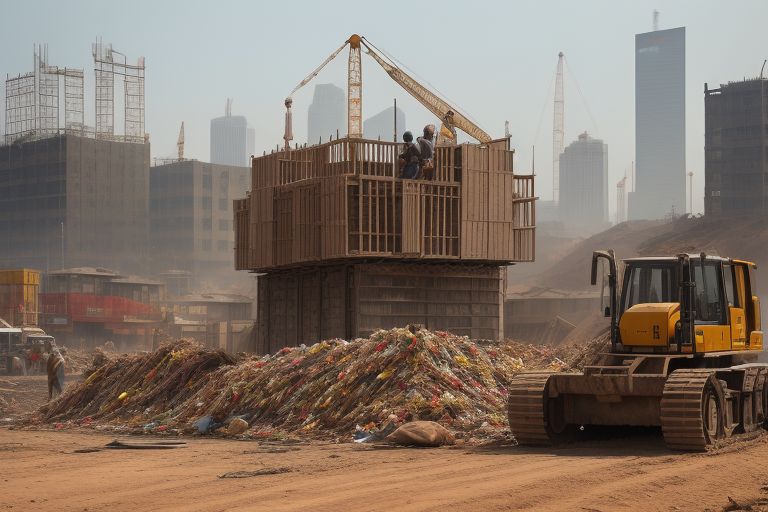
4. Impact of Construction Waste
Understanding the impact of construction waste is critical for grasping the full implications of waste management on environmental sustainability and project efficiency. Construction waste not only affects the immediate project environment but also has broader consequences for the ecosystem and community. This section explores how construction waste impacts the environment, economy, and society, highlighting the importance of effective waste management practices.
Key Areas of Focus:
- Environmental Impact: Examines how construction waste contributes to pollution, resource depletion, and the degradation of natural habitats.
- Economic Impact: Discusses the financial implications of waste, including disposal costs and the potential for cost savings through efficient waste management.
- Social Impact: Considers how waste management practices affect communities, including health risks associated with waste and the benefits of cleaner, more sustainable construction practices.
Key Points:
1. Environmental Impact
Construction waste has a profound impact on the environment, primarily through contributions to landfill overflow, pollution, and habitat destruction. When waste is not managed or disposed of properly, it can lead to a range of environmental issues that affect ecosystems, air and water quality, and overall environmental health.
Examples:
- Landfill Leachate: When construction waste is deposited in landfills, it can decompose and produce leachate, a liquid that filters through the waste. This leachate can contain harmful chemicals and pollutants, which can leach into groundwater and soil, leading to contamination of drinking water sources and disruption of local ecosystems.
- Greenhouse Gas Emissions: As construction waste decomposes in landfills, it releases greenhouse gases, including methane and carbon dioxide. Methane is a particularly potent greenhouse gas that contributes to global warming and climate change. The emission of these gases from decomposing waste accelerates the greenhouse effect, exacerbating environmental and climatic issues.
Understanding these environmental impacts highlights the need for effective waste management strategies that aim to minimize waste production, enhance recycling, and reduce the harmful effects of construction waste on the environment.
2. Economic Impact
The management and disposal of construction waste involve significant costs that can influence project budgets and overall financial planning. While effective waste management strategies can help reduce these costs, poor waste management practices can lead to additional expenses and financial penalties. Understanding the economic impact of construction waste is crucial for cost-effective project management and long-term financial planning.
Examples:
- Disposal Fees: The costs of transporting and disposing of construction waste can be substantial. Fees vary depending on the type and volume of waste, the disposal site, and regional regulations. High disposal fees can significantly impact the overall project budget, making waste management a critical aspect of financial planning.
- Additional Costs: Beyond disposal fees, managing construction waste involves other expenses, such as sorting and recycling waste materials, maintaining waste management equipment, and ensuring compliance with regulations. These additional costs can accumulate, further affecting the financial viability of a project.
- Potential Fines: Failure to adhere to local regulations and standards regarding construction waste management can result in fines and legal penalties. Non-compliance with waste management regulations can lead to costly legal issues, impacting the project’s budget and potentially leading to delays and additional expenses.
Effective waste management not only helps to control and reduce these costs but also enhances overall project efficiency and compliance, contributing to a more sustainable and economically viable construction process.
3. Social Impact
Ineffective management of construction waste can have detrimental effects on local communities, impacting residents’ health, well-being, and overall quality of life. Poor waste practices can lead to various environmental and social issues, creating challenges for neighborhoods and communities.
Examples:
- Dust and Noise Pollution: Construction sites and waste management operations can generate significant dust and noise, which can negatively impact the health and comfort of nearby residents. Prolonged exposure to dust can lead to respiratory issues, while excessive noise can cause stress and disrupt daily activities. Effective management practices, such as dust suppression and noise control measures, are crucial to minimizing these adverse effects.
- Visual Pollution: Accumulated construction waste and poorly managed disposal sites can create unattractive and unsightly environments. The presence of visible waste piles and cluttered areas can diminish the aesthetic appeal of neighborhoods, leading to decreased property values and reduced community pride. Proper waste management and site cleanup help maintain a visually pleasing environment and enhance the overall quality of life for residents.
Addressing these social impacts through proactive waste management and community engagement can lead to healthier, more attractive, and more cohesive neighborhoods, contributing to a better living environment for all.
Understanding these impacts underscores the importance of implementing effective waste management practices to mitigate negative effects and promote a healthier, more sustainable environment.
Reflection Element:
Reflect on the potential impacts of construction waste on a local community and think about ways to minimize these impacts.

5. Best Practices for Understanding and Managing Construction Waste
Effective management of construction waste is crucial for minimizing environmental impact, reducing costs, and enhancing project efficiency. Understanding and implementing best practices for managing construction waste involves a strategic approach to waste reduction, recycling, and disposal. This section will provide you with key strategies and practices to optimize waste management, ensuring that construction projects are not only cost-effective but also environmentally responsible.
By adopting best practices in waste management, you can achieve significant benefits including reduced waste generation, lower disposal costs, and compliance with regulatory requirements. This section will cover practical techniques for waste segregation, material reuse, recycling, and disposal, as well as strategies for integrating these practices into project planning and execution.
Prepare to explore effective methods for managing construction waste that can help you contribute to a more sustainable and efficient construction industry.
Key Points:
1. Waste Audits and Assessments
Conducting regular waste audits and assessments is a fundamental practice in managing construction waste effectively. These audits involve systematically tracking and analyzing waste generation on construction sites to gain a comprehensive understanding of the types and quantities of waste produced. By collecting data on waste types, sources, and disposal methods, construction teams can make informed decisions that lead to improved waste management practices.
Key Components of Waste Audits and Assessments
- Data Collection:
- Types of Waste: Identify and categorize the different types of waste generated on-site, such as concrete, wood, metal, drywall, and hazardous materials.
- Sources of Waste: Analyze where the waste is coming from, whether it’s from material over-ordering, construction processes, or packaging.
- Disposal Methods: Document how waste is currently being disposed of, including landfill, recycling, or reuse.
- Frequency of Audits:
- Regular audits should be scheduled throughout the project lifecycle, ideally at key milestones or phases of construction. This ensures that waste generation is monitored consistently and allows for timely adjustments to waste management strategies.
- Engagement of Personnel:
- Involve construction teams in the audit process to foster a sense of ownership and responsibility towards waste management. Training sessions can be conducted to educate staff on the importance of accurate data collection and reporting.
- Analysis and Reporting:
- After data collection, analyze the information to identify trends, patterns, and areas of concern. Create reports that summarize findings and highlight key insights for stakeholders.
Benefits of Waste Audits and Assessments
- Identifies Key Areas for Improvement: By analyzing waste data, construction teams can pinpoint specific areas where waste is generated excessively. For example, if audits reveal that a significant amount of wood waste is produced during framing, targeted strategies can be developed to optimize material use, such as better cutting techniques or improved ordering practices. This targeted approach allows for more effective interventions that can lead to substantial waste reduction.
- Informs Waste Management Plans: The insights gained from waste audits are invaluable for creating effective waste management plans tailored to the specific needs of the project. By understanding the types and quantities of waste generated, project managers can develop strategies that prioritize waste reduction, recycling, and reuse. This leads to more efficient resource use, minimizes environmental impact, and ensures compliance with regulatory requirements.
- Enhances Accountability: Regular audits create a culture of accountability among team members. When personnel are aware that their waste generation is being monitored, they are more likely to adopt sustainable practices and take responsibility for their actions.
- Facilitates Continuous Improvement: Waste audits provide a baseline for measuring progress over time. By conducting audits at regular intervals, construction teams can track improvements in waste management practices and make necessary adjustments to enhance efficiency and sustainability.
- Supports Cost Savings: By identifying areas of excessive waste generation and implementing targeted strategies, construction projects can achieve significant cost savings. Reduced waste disposal fees and more efficient use of materials can lead to lower overall project costs.
Waste audits and assessments are essential tools for understanding and managing construction waste effectively. By systematically tracking and analyzing waste generation, construction teams can identify key areas for improvement, inform waste management plans, and foster a culture of sustainability on-site. The benefits of conducting regular audits extend beyond waste reduction; they contribute to cost savings, regulatory compliance, and the overall success of construction projects. Embracing this practice is a crucial step towards a more sustainable construction industry.

2. Training and Awareness
Providing comprehensive training to construction teams on waste management and reduction techniques is vital for fostering a culture of sustainability on-site. Effective training programs equip personnel with the knowledge and skills necessary to implement best practices for waste segregation, recycling, and minimizing waste generation. By prioritizing training and awareness, construction companies can create a workforce that is not only informed but also motivated to contribute to sustainable practices.
Key Components of Training and Awareness Programs
- Curriculum Development: Develop a structured training curriculum that covers essential topics such as waste types, waste segregation methods, recycling processes, and strategies for waste minimization. The curriculum should be tailored to the specific needs of the project and the types of materials commonly used.
- Interactive Training Sessions: Conduct interactive training sessions that engage participants through discussions, hands-on activities, and real-life case studies. This approach helps reinforce learning and encourages team members to think critically about waste management practices.
- Onboarding for New Employees: Integrate waste management training into the onboarding process for new employees. This ensures that all team members, regardless of their experience level, understand the importance of waste management from the outset.
- Ongoing Education: Establish a system for ongoing education and refresher courses to keep team members updated on the latest waste management practices, technologies, and regulatory changes. This can include workshops, seminars, or online training modules.
- Visual Aids and Resources: Provide visual aids, such as posters and infographics, that outline waste management procedures and best practices. These resources can serve as constant reminders for team members and help reinforce training concepts.
Benefits of Training and Awareness
- Ensures Compliance: Training ensures that all personnel are aware of and follow best practices for waste management, which is crucial for meeting regulatory requirements. By understanding the legal obligations related to waste disposal and recycling, team members can help avoid potential fines and penalties associated with non-compliance. This proactive approach not only protects the company but also promotes a responsible work environment.
- Enhances Team Engagement: When team members understand the impact of their actions on waste generation, they are more likely to engage in sustainable practices. Training fosters a sense of ownership and responsibility, encouraging individuals to take initiative in waste reduction efforts. This collective effort can lead to significant improvements in waste management on-site, as team members collaborate to identify and implement solutions.
- Promotes a Culture of Sustainability: Training and awareness initiatives contribute to the development of a culture of sustainability within the organization. When waste management is prioritized and integrated into daily operations, it becomes a core value that guides decision-making and behavior among all team members.
- Improves Efficiency: Educated personnel are better equipped to identify inefficiencies in material use and waste generation. By understanding best practices, team members can optimize processes, leading to reduced waste and improved project efficiency.
- Encourages Innovation: Training programs can inspire team members to think creatively about waste management solutions. When employees are knowledgeable about sustainable practices, they may propose innovative ideas for reducing waste, reusing materials, or enhancing recycling efforts, ultimately benefiting the project and the environment.
- Strengthens Team Cohesion: Engaging in training as a group fosters teamwork and collaboration. Team members can share experiences, discuss challenges, and work together to develop solutions, strengthening relationships and enhancing overall project performance.
Training and awareness are critical components of effective waste management in the construction industry. By providing construction teams with the knowledge and skills necessary to implement best practices, companies can ensure compliance with regulations, enhance team engagement, and promote a culture of sustainability on-site. The benefits of investing in training extend beyond waste reduction; they contribute to improved efficiency, innovation, and overall project success. Embracing training and awareness initiatives is a vital step towards building a more sustainable and responsible construction industry.
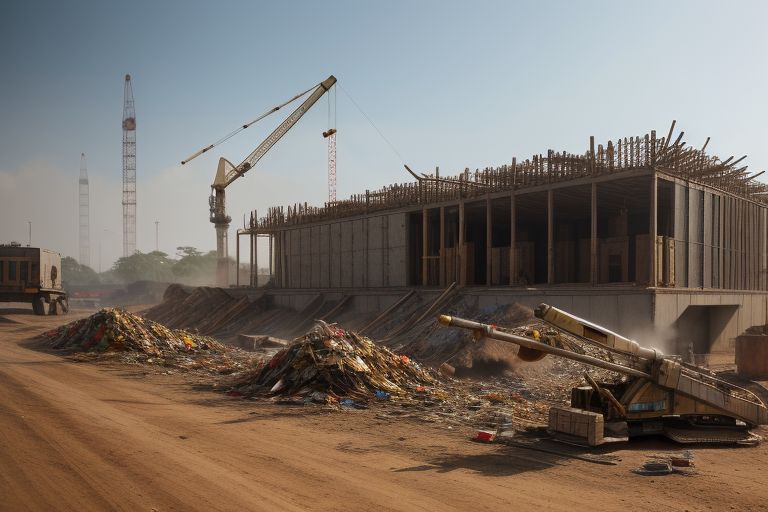
3. Waste Minimization Strategies
Implementing effective waste minimization strategies is a proactive approach to waste management that can significantly reduce the environmental impact of construction projects. By focusing on reducing waste generation at the source, construction teams can enhance efficiency, lower costs, and contribute to a more sustainable industry. Key strategies for waste minimization include precise ordering of materials, efficient use of materials, and establishing recycling protocols for reusable materials.
Key Waste Minimization Strategies
- Precise Ordering of Materials:
- Description: Accurate forecasting and ordering of materials are essential to avoid over-purchasing. This involves careful planning and collaboration with suppliers to ensure that the right quantities of materials are ordered based on project specifications and timelines.
- Implementation: Utilize project management software and inventory tracking systems to monitor material usage and adjust orders accordingly. Engage in regular communication with suppliers to understand lead times and availability, allowing for more accurate ordering.
- Efficient Use of Materials:
- Description: Maximizing the efficient use of materials during construction can significantly reduce waste. This includes optimizing cutting techniques, reusing off-cuts, and employing modular construction methods where feasible.
- Implementation: Train workers on best practices for material handling and cutting to minimize waste. Encourage the use of design techniques that allow for the reuse of materials, such as designing components that can be prefabricated and assembled on-site.
- Establishing Recycling Protocols:
- Description: Setting up clear recycling protocols for materials that can be reused is crucial for minimizing waste. This includes identifying recyclable materials such as metals, concrete, wood, and plastics, and establishing designated areas for collection and processing.
- Implementation: Collaborate with local recycling facilities to understand their requirements and capabilities. Create a waste segregation system on-site to ensure that recyclable materials are separated from general waste, making it easier to divert them from landfills.
- Material Reuse:
- Description: Encouraging the reuse of materials from previous projects or salvaged materials can significantly reduce the need for new materials and minimize waste.
- Implementation: Develop a system for tracking and storing reusable materials on-site. Create partnerships with local organizations or businesses that specialize in salvaging and reselling construction materials.
- Design for Disassembly:
- Description: Incorporating design principles that facilitate disassembly can lead to reduced waste at the end of a building’s life cycle. This approach allows for easier reuse and recycling of materials.
- Implementation: Work with architects and designers to create structures that can be easily taken apart and have components that can be reused or recycled.
Benefits of Waste Minimization Strategies
- Reduces Volume of Waste: By focusing on waste minimization, construction projects can significantly decrease the amount of waste produced on-site. This reduction not only benefits the environment by lowering the amount of material sent to landfills but also lessens the burden on waste disposal facilities, contributing to a more sustainable waste management system.
- Lowers Disposal Costs: With less waste to dispose of, construction projects can save on disposal fees, leading to overall cost savings. These savings can be reinvested into other project areas, such as improving materials, enhancing safety measures, or investing in sustainable technologies. Lower disposal costs also contribute to a more competitive project budget, allowing for better resource allocation.
- Enhances Project Efficiency: Implementing waste minimization strategies can lead to improved project efficiency. By reducing waste, construction teams can streamline operations, minimize delays caused by material shortages, and enhance overall productivity.
- Promotes Sustainability: Waste minimization aligns with broader sustainability goals, helping construction companies reduce their carbon footprint and environmental impact. By adopting these strategies, companies can demonstrate their commitment to sustainable practices, which can enhance their reputation and attract environmentally conscious clients.
- Encourages Innovation: Focusing on waste minimization can inspire innovative approaches to construction processes and materials. Teams may explore new technologies, materials, and methods that not only reduce waste but also improve the quality and durability of construction projects.
Implementing waste minimization strategies is a critical component of effective waste management in the construction industry. By prioritizing precise ordering, efficient material use, recycling protocols, and material reuse, construction teams can significantly reduce waste generation, lower disposal costs, and enhance project efficiency. Embracing these strategies not only benefits the environment but also contributes to the overall success and sustainability of construction projects. By fostering a culture of waste minimization, the construction industry can take meaningful steps towards a more sustainable future.
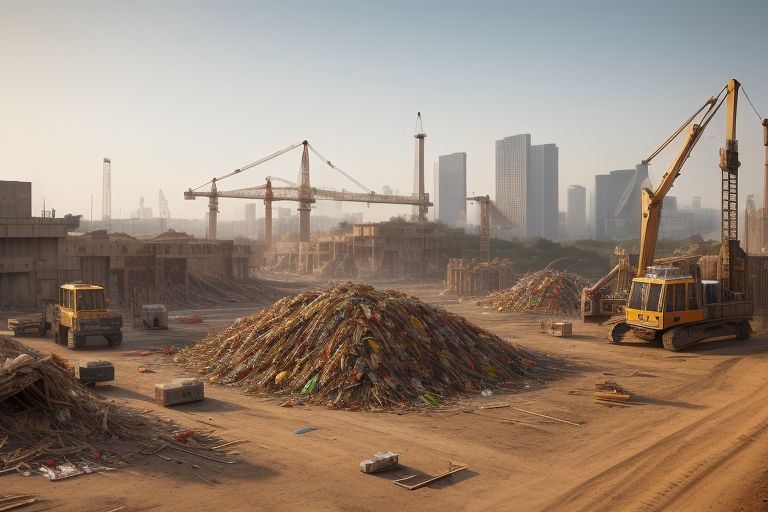
4. Waste Segregation
Implementing a waste segregation system on construction sites is a crucial step in effective waste management. By separating recyclable materials from general waste, construction teams can significantly enhance recycling efforts and minimize the amount of waste sent to landfills. A well-organized waste segregation system involves the use of designated bins for different types of materials, such as wood, metal, concrete, and hazardous waste, ensuring that each material is disposed of or recycled appropriately.
Key Components of Waste Segregation
- Designated Bins:
- Description: Set up clearly labeled bins for different types of waste materials. Common categories include:
- Wood: For scrap wood, pallets, and other wooden materials.
- Metal: For ferrous and non-ferrous metals, including steel, aluminum, and copper.
- Concrete: For leftover concrete and masonry materials.
- Hazardous Waste: For materials that require special handling, such as paints, solvents, and chemicals.
- General Waste: For non-recyclable materials that cannot be reused or recycled.
- Implementation: Ensure that bins are easily accessible and strategically placed throughout the construction site to encourage proper disposal.
- Description: Set up clearly labeled bins for different types of waste materials. Common categories include:
- Clear Signage and Instructions:
- Description: Use clear signage to indicate the purpose of each bin and provide instructions on what materials should be placed in each one. Visual aids, such as images or color-coded labels, can enhance understanding.
- Implementation: Train personnel on the importance of waste segregation and how to use the bins correctly. Regular reminders and visual cues can reinforce proper practices.
- Regular Monitoring and Maintenance:
- Description: Establish a routine for monitoring the waste segregation system to ensure that it is functioning effectively. This includes checking bin levels, emptying bins regularly, and maintaining cleanliness around the waste disposal areas.
- Implementation: Assign team members to oversee the waste segregation process and address any issues that arise, such as contamination of recyclable materials.
- Training and Awareness:
- Description: Provide training sessions for all personnel on the importance of waste segregation and the specific procedures to follow. This training should cover the types of materials that can be recycled and the environmental benefits of proper waste management.
- Implementation: Incorporate waste segregation training into onboarding processes for new employees and conduct refresher courses for existing staff.
Benefits of Waste Segregation
- Improves Recycling Rates: Proper segregation of waste materials significantly increases the likelihood that recyclable materials will be processed and reused rather than sent to landfills. By ensuring that materials are sorted correctly, construction teams can divert a substantial portion of their waste from disposal, contributing to a circular economy and reducing the environmental impact of construction activities.
- Facilitates Compliance: Many regulations and local ordinances require specific waste management practices, including waste segregation. By implementing a waste segregation system, construction companies can ensure compliance with these regulations, helping to avoid potential fines and legal issues. Compliance not only protects the company but also demonstrates a commitment to responsible environmental practices.
- Enhances Resource Recovery: Effective waste segregation allows for the recovery of valuable materials that can be recycled and reused in new construction projects. This not only conserves natural resources but also reduces the demand for new materials, leading to lower environmental impact and cost savings.
- Promotes a Culture of Sustainability: A well-implemented waste segregation system fosters a culture of sustainability on-site. When team members actively participate in waste management practices, it encourages a collective responsibility towards environmental stewardship and promotes awareness of the importance of reducing waste.
- Reduces Contamination: By keeping recyclable materials separate from general waste, the risk of contamination is minimized. Contaminated recyclables are often sent to landfills, negating the benefits of recycling efforts. Proper segregation helps maintain the integrity of recyclable materials, ensuring they can be processed effectively.
- Improves Project Efficiency: A systematic approach to waste segregation can streamline waste management processes, making it easier to track waste generation and disposal. This efficiency can lead to better planning and resource allocation, ultimately enhancing overall project performance.
Implementing a waste segregation system on construction sites is a vital practice for effective waste management. By separating recyclable materials from general waste, construction teams can improve recycling rates, facilitate compliance with regulations, and promote a culture of sustainability. The benefits of waste segregation extend beyond environmental impact; they contribute to project efficiency, resource recovery, and overall cost savings. Embracing waste segregation as a standard practice is a crucial step towards building a more sustainable construction industry.
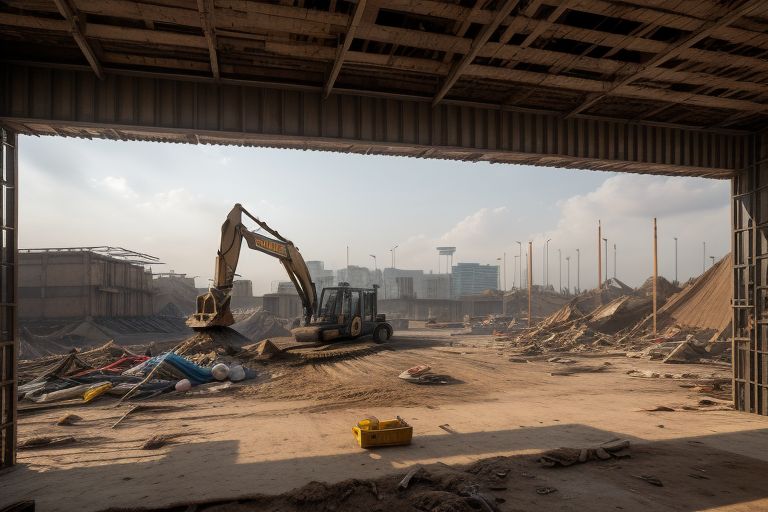
5. Collaboration with Waste Management Companies
Partnering with local waste management companies that specialize in construction waste is a strategic approach to enhancing waste management practices on construction sites. These partnerships can provide valuable resources, expertise, and innovative solutions for recycling and disposal, ultimately contributing to more sustainable construction practices.
Key Components of Collaboration
- Identifying Local Waste Management Partners:
- Description: Research and identify local waste management companies that have experience in handling construction waste. Look for companies that offer a range of services, including recycling, disposal, and waste auditing.
- Implementation: Evaluate potential partners based on their reputation, services offered, and commitment to sustainability. Consider visiting their facilities to understand their processes and capabilities.
- Establishing Clear Communication:
- Description: Develop open lines of communication with waste management partners to ensure that both parties are aligned on goals, expectations, and procedures. Regular meetings can facilitate collaboration and address any challenges that arise.
- Implementation: Create a communication plan that outlines how information will be shared, including updates on waste generation, recycling rates, and any changes in regulations or practices.
- Tailoring Waste Management Solutions:
- Description: Work with waste management companies to develop customized waste management solutions that meet the specific needs of your construction projects. This may include tailored recycling programs, waste audits, and training for on-site personnel.
- Implementation: Collaborate on creating a waste management plan that outlines the types of materials to be recycled, collection schedules, and disposal methods.
- Training and Education:
- Description: Leverage the expertise of waste management partners to provide training and educational resources for construction teams. This can include workshops on recycling practices, waste reduction techniques, and regulatory compliance.
- Implementation: Schedule training sessions led by waste management experts to ensure that all personnel are informed about best practices and the importance of effective waste management.
Benefits of Collaboration with Waste Management Companies
- Access to Resources: Partnering with waste management companies provides access to valuable resources and insights into best practices for waste management. These companies often have extensive experience in the industry and can offer guidance on optimizing waste reduction strategies, recycling processes, and compliance with regulations. Their expertise can help construction teams implement more effective waste management practices.
- Enhanced Recycling Opportunities: Collaborating with experts in waste management can lead to increased recycling rates and innovative solutions for waste reduction. Waste management companies often have established networks for recycling materials and can facilitate the diversion of waste from landfills. They may also introduce new technologies or methods for recycling that can further enhance sustainability efforts on construction sites.
- Improved Compliance: Waste management companies are typically well-versed in local regulations and requirements related to waste disposal and recycling. By partnering with these experts, construction teams can ensure compliance with relevant laws, reducing the risk of fines and legal issues. This partnership can also help in navigating complex regulatory landscapes, making it easier to adhere to best practices.
- Cost Savings: Effective collaboration can lead to cost savings through optimized waste management processes. By reducing the volume of waste sent to landfills and increasing recycling rates, construction projects can lower disposal fees and potentially generate revenue from recyclable materials. These savings can be reinvested into other project areas, enhancing overall project efficiency.
- Sustainability Reporting: Many waste management companies offer reporting services that track waste generation, recycling rates, and disposal methods. This data can be invaluable for sustainability reporting and demonstrating the environmental impact of construction projects. By having access to accurate data, construction teams can make informed decisions and communicate their sustainability efforts to stakeholders.
- Innovation and Continuous Improvement: Collaborating with waste management companies can foster a culture of innovation and continuous improvement in waste management practices. These companies often stay updated on the latest trends, technologies, and regulations in waste management, providing construction teams with insights that can lead to more effective and sustainable practices.
Collaboration with local waste management companies is a vital strategy for enhancing waste management practices in the construction industry. By leveraging the expertise and resources of these partners, construction teams can improve recycling rates, ensure compliance with regulations, and implement innovative waste reduction solutions. The benefits of such collaboration extend beyond environmental impact; they contribute to cost savings, improved project efficiency, and a stronger commitment to sustainability. Embracing partnerships with waste management experts is a crucial step towards building a more sustainable and responsible construction industry.
6. Continuous Improvement
Partnering with local waste management companies that specialize in construction waste is a strategic approach to enhancing waste management practices on construction sites. These partnerships can provide valuable resources, expertise, and innovative solutions for recycling and disposal, ultimately contributing to more sustainable construction practices.
Key Components of Collaboration
- Identifying Local Waste Management Partners:
- Description: Research and identify local waste management companies that have experience in handling construction waste. Look for companies that offer a range of services, including recycling, disposal, and waste auditing.
- Implementation: Evaluate potential partners based on their reputation, services offered, and commitment to sustainability. Consider visiting their facilities to understand their processes and capabilities.
- Establishing Clear Communication:
- Description: Develop open lines of communication with waste management partners to ensure that both parties are aligned on goals, expectations, and procedures. Regular meetings can facilitate collaboration and address any challenges that arise.
- Implementation: Create a communication plan that outlines how information will be shared, including updates on waste generation, recycling rates, and any changes in regulations or practices.
- Tailoring Waste Management Solutions:
- Description: Work with waste management companies to develop customized waste management solutions that meet the specific needs of your construction projects. This may include tailored recycling programs, waste audits, and training for on-site personnel.
- Implementation: Collaborate on creating a waste management plan that outlines the types of materials to be recycled, collection schedules, and disposal methods.
- Training and Education:
- Description: Leverage the expertise of waste management partners to provide training and educational resources for construction teams. This can include workshops on recycling practices, waste reduction techniques, and regulatory compliance.
- Implementation: Schedule training sessions led by waste management experts to ensure that all personnel are informed about best practices and the importance of effective waste management.
Benefits of Continuous Improvement
- Adaptability: Regularly reviewing and updating waste management strategies allows construction teams to adapt to project needs and emerging best practices. This adaptability is crucial in a dynamic industry where project conditions, regulations, and technologies can change rapidly. By being responsive to these changes, teams can implement more effective waste management practices that align with current standards and expectations.
- Long-term Sustainability: A commitment to continuous improvement fosters a culture of sustainability that extends beyond individual projects. By embedding sustainability into the core values of the organization, construction companies can influence the broader industry and contribute to systemic change. This culture encourages innovation, collaboration, and a shared responsibility for environmental stewardship among all team members.
- Enhanced Efficiency: Continuous improvement leads to enhanced efficiency in waste management processes. By regularly assessing practices and implementing improvements, construction teams can streamline operations, reduce waste generation, and optimize resource use. This efficiency can result in cost savings and improved project timelines.
- Increased Stakeholder Engagement: Demonstrating a commitment to continuous improvement in waste management can enhance stakeholder engagement and trust. Clients, investors, and regulatory bodies are increasingly focused on sustainability, and showcasing a proactive approach to waste management can strengthen relationships and improve the company’s reputation.
- Innovation and Best Practices: A culture of continuous improvement encourages innovation and the adoption of best practices in waste management. By staying informed about new technologies, materials, and methods, construction teams can implement cutting-edge solutions that further enhance sustainability and efficiency.
- Measurable Impact: Establishing a feedback loop allows for the measurement of the impact of waste management practices over time. By tracking progress and outcomes, construction teams can demonstrate the effectiveness of their efforts and make data-driven decisions for future projects.
Continuous improvement is a vital component of effective waste management in the construction industry. By establishing a feedback loop to assess and refine waste management practices, construction teams can enhance adaptability, drive long-term sustainability, and foster a culture of innovation. The benefits of continuous improvement extend beyond individual projects, influencing the broader construction industry and contributing to a more sustainable future. Embracing this commitment to ongoing assessment and enhancement is essential for achieving meaningful progress in waste management and environmental stewardship.
By implementing these best practices, construction professionals can significantly reduce waste generation, lower costs, and contribute to a more sustainable construction industry. Embracing effective waste management strategies not only benefits the environment but also enhances the overall efficiency and reputation of construction projects.
Reflection Element:
Reflect on how a waste management plan for a construction project in your previous or current work experience could implement strategies for reducing, reusing, and recycling materials.
As we conclude Lesson 5.1 on Understanding Construction Waste, we hope you have gained valuable insights into the importance of effective waste management practices in the construction industry. By implementing strategies such as waste audits, training and awareness, waste minimization, segregation, collaboration with waste management companies, and continuous improvement, you can significantly reduce waste generation and contribute to a more sustainable future.
Remember, the journey towards sustainability in construction is ongoing, and every effort counts. By adopting these best practices, you not only enhance project efficiency and compliance but also play a crucial role in protecting our environment for future generations.
We invite you to join us for the next lesson, 5.2 Strategies for Waste Reduction, where we will delve deeper into practical techniques and innovative approaches to further minimize waste on construction sites. Together, we can explore actionable strategies that will empower you to make a meaningful impact in your projects and the broader construction industry.
Thank you for your participation, and we look forward to seeing you in the next lesson!

